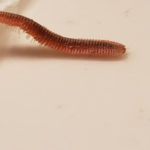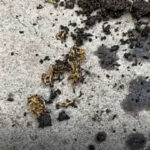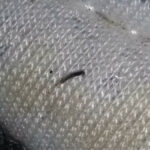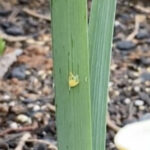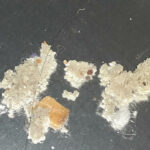Many myths surround the popularity of the tequila worm. First, you won’t find it in a bottle of just any tequila. Its final resting place is actually in mezcal. Tequila is mezcal (or mescal), but must be derived from only the blue agave plant. Mezcal, the drink of choice for tequila worm consumption, comes from a variety of agave – or maguey – plants.
Depending on whom you ask, a tequila worm may be the caterpillar stage of several butterfly or moth species. It is not a worm, of course, but a fat coral or gold larva that gently fades to pink or white as it ages in a bottle of mezcal. Aficionados of the tequila worm believe that only the reddish worm should be used, but as this species becomes harder to find and harvest, the gold larval bodies are becoming acceptable. In fact, some mezcal manufacturers pride themselves on including a wide range of tequila worm species that they state boosts the flavor and smell of the mezcal.
Entomological descriptions for the tequila worm can be confusing. It is known as the agave worm or maguey worm. “Gusano” is the Spanish word for worm. The coral tequila worm (gusano rojo), which is thought to be the most tasty, buries into the pineapple-shaped center of an agave plant. The gold varieties (gusano de oro) tend to feed on the outer leaves. Some gusanos are members of a subfamily of butterflies referred to as Hipopta agavis. Others are the caterpillar stage of the skipper butterfly (Aegiale hesperiasis) or may be identified as a carpenter worm (Comadia redtenbacheri).
Legends that surround the tequila worm include its magical powers that can impart strength to the consumer. Some claim it to be hallucinogenic or an aphrodisiac. In fact, the tequila worm was not introduced into mezcal production until the 1950s – as a marketing gimmick – and has no historical Mexican claims or fantastic properties.
If you own an agave plant, you may have to worry about tequila worm poachers. In fact, many mezcal producers place patrols along the perimeters of their properties as worm-collecting can be quite profitable.
The tequila worm is perfectly safe to eat. They are fried and eaten, sans mezcal, in Mexico, as part of a protein-rich diet. Some specialty markets even carried canned tequila worms. Just add a spicy sauce and you have a nutritious snack.
Recommended reading (click on the picture for details):
All About Worms is always free, always reader-supported. Your tips via CashApp, Venmo, or Paypal are appreciated! Receipts will come from ISIPP Publishing.





